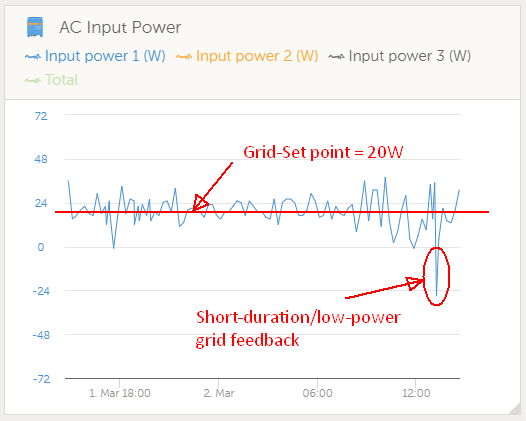Hi,
I have two Questions created already where i have discussed various issues regarding my solution. See here :
https://community.victronenergy.com/questions/41291/multiplus-ii-disable-feed-back-entirely-possible.html and https://community.victronenergy.com/questions/42279/lom-detection-when-feed-in-disabled-why.html?childToView=42916#comment-42916
I am sorry that i now create another issue but i am not confident that what i want can indeed be done with the chosen HW/solution.
Background:
I am located in Denmark and wish to buy Victron products to make a hybrid/off-grid system where "All" i want is that i can pull/mix power from grid when i don't have battery/solar but NEVER feedback to the grid, just one little bit will get me into trouble. I assume feed-back and feed-in are the same things right ? The most important thing for me is to not feedback to grid and be able to pull and use the produced energy myself. I think this is called self consumption.
I read on https://www.victronenergy.com/live/ve.bus:grid-codes-and-loss-of-mains-detection :
Q4: I use ESS, but have disabled feed-back, is a grid-code still required?A: Yes, also in this case LOM is required to make for a safe and also local regulations compliant system. Running ESS with disabled-feed-back is still not the same as using a Multi in its default configuration without ESS.
I don't understand why do i need LOM for this ? Can somebody explain ?
Regarding my usage :
We (our family) have roughly 16-20kw consumption per day and in total 6000-7000kW yearly. I will also have a powerwall build myself using LiFePo4 batteries (48v) roughly a 10-15kwh.
System i have in mind :
1 x Multiplus II 5000/48
2 x SmartSolar 250/60
1 x Venus GX
I have 21pcs of 310W panels (https://bit.ly/2P1GL9O) so i was thinking to place 10 on each side of the roof meaning i would do 2 x 5 panels in series so i would have 200V for 5 panels then parallel the 2 strings and one string is 10A so 200V 20A for one charge controller. I think that is ok but that means I need to use the 250/60 solar charger model which is more expensive and i need two of those. Please correct if i am wrong.
I have 100% stable grid connection and since the Multiplus II can handle a big load in by pass i can practically run the whole house on the AC out from the inverter. Please correct if i am wrong.
Questions:
- I want to know if the above system is feasible ? Are there any other Victron HW that i also need which is not on my list above ?
- Can I use the system in such a way that i NEVER feed-in/feeback to grid in no circumstance but at the same time i can consume from the grid when no solar or battery is available ?
- If 2 is possible can the system be programmed in such a way that when the load is too big for solar alone or solar/battery combined to also mix in grid power BUT still without feed-in/feedback to the grid ?
- If 2 and 3 is feasible what do i need ? Do i need ESS or ignore AC input or both if that's possible ? How would one configure ?

